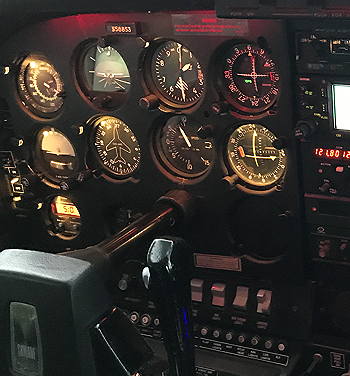Subscriber question:
"How should I respond to an alternator failure at night? " — Geoff V.
Ryan:
 “When your only alternator fails at night, it’s an emergency. Declaring buys you extra ATC attention and priority handling. That’s exactly what you need, so don’t hesitate. Then, land as soon as practical.
“When your only alternator fails at night, it’s an emergency. Declaring buys you extra ATC attention and priority handling. That’s exactly what you need, so don’t hesitate. Then, land as soon as practical.
How much battery time you have depends on the health and size of your battery, as well as how quickly you notice and respond to the failure. Get the most out of what juice you have left by turning off as much as you reasonably can. Your checklist will tell you that, but probably doesn’t offer specific guidance for which items to turn off. It might be more items than you think.
Newer LED lights don’t draw much power, but turn off nonessential ones anyway. Older lights, especially strobes, draw much more. Consider turning them all off. Pitot heat uses a lot of power, but don’t turn it off if you need it. You have enough problems without losing your airspeed indication.
You can likely turn off one radio, and possibly your transponder if you’re not being vectored by ATC. If you have an iPad you can navigate with, turn off the GPS too. Keep radio transmissions to a minimum—they’re a significant power draw—and consider using a handheld radio proactively.
Autopilots use electricity for both the computers and servos. Even when disengaged, many autopilots consume some power to monitor the situation. So turn it off, pull the breaker, and hand fly.
Dim the backlighting on glass displays as low as possible. If you have instruments with internal battery backups, like Garmin G5s or Aspen displays, understand how to make them switch to their internal batteries. Some sense the voltage drop caused by an alternator failure and automatically switch. Others don’t, which means you must pull a breaker to force them to use their internal batteries. Consider figuring all this out on the ramp someday and making a custom checklist you can pull out in flight if this ever happens to you for real.
If you need more range than the battery alone will provide, you still have an option: Turn off the master switch and fly by iPad or dead reckoning until you’re in range of an airport. Then turn the master back on and you’ll have power to spare when you need it most. This is even an option in IMC on an IFR flight plan. This is an emergency, and you won’t be able to fly an approach if the battery runs dry. Let ATC know when and where you plan to turn your radios back on, and they’ll provide a frequency to call, and the controllers there will be expecting you.
Remember that you need electrical power to activate pilot-controlled lighting, as well as for electric flaps and landing gear. Play your cards wrong, and you might be making a manual gear extension, followed by a no-flap landing to an unlit runway in a NORDO, unlit plane. Stack the odds in your favor by diverting to an airport with a tower. Tell ATC your plan and ETA before the battery dies. Even if the Tower controllers can’t see you to send light gun signals, they can keep other traffic away until you arrive.
So know your aircraft, and do what it takes to get on the ground while you still have some juice left.”
How comfortable are you flying single-engine at night?
